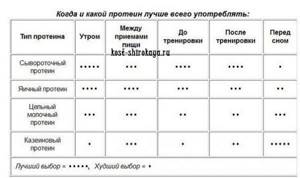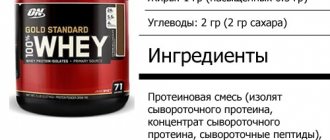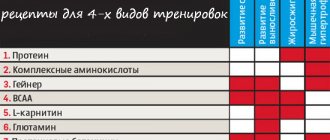Typically, standard protein packages have a special scoop for determining volume. With its help, the user can easily dose the powder. But in soft packages there is usually no such assistant, so you have to use a regular spoon.
The optimal dosage of protein is determined in relation to the athlete’s body weight and the desired result from training. That is, it is imperative to follow the gram limits - an excess of protein can have a detrimental effect on the body. In the best case, such a dose simply will not be absorbed in the human body and will be released naturally. But most often you can run into an unpleasant side effect. To prevent this from happening, it is recommended to use at least some measuring equipment, including a tablespoon.
We pay attention to details
When planning the dosage and timing of protein intake, one important thing to consider is that there are “slow” and “fast” proteins. That is, one group of proteins is absorbed by the body in 5-7 hours, and the other in 20-50 minutes. The difference is significant, you will agree. Now for examples.
One of the most popular and sought after supplements among bodybuilders is whey protein.
The main reason is the high percentage of protein (in isolate it can reach 95%), excellent digestibility by the body (from 20 to 50 minutes) and a rich composition of amino acids, which is so necessary for muscle fibers for growth and recovery. If you need to quickly charge and “nourish” the body after a workout, whey “fast” protein comes to the rescue.
In turn, casein and soy proteins are “slow” - the body absorbs them within 5-7 hours. But this does not mean that their composition is worse than that of their competitors. Not at all. The whole difference is in the structure of the protein, which is difficult to break down in the stomach. But if taken correctly, this is more of a plus than a minus. Eating “slow” protein is a chance to stop catabolic processes in the body and provide muscles with amino acids for many hours to come.
Sports nutrition
Sports nutrition (sports nutrition) is a concentrated dry food that helps you get the necessary nutrients quickly and in large quantities, so taking sports nutrition (sports nutrition) should not cause any panic. Moreover, in this form they are more easily absorbed by the body: it does not need to break down anything, etc., everything has already been done.
By the way, vitamin complexes are also a type of food supplement. If a person takes vitamins, you also do not consider him a chemist, you do not think that he is doing something forbidden.
So, sports nutrition is a concentrate of nutrients. For example, one serving of quality protein contains about 25-30 grams of protein. This is a ready-made substance, which, upon entering the body, immediately begins to be absorbed. If an athlete tries to gain the required amount of protein from foods, he will create an increased load on the digestive organs. So it turns out that the harm of protein is not just a misconception, but a dangerous misconception.
For example, amino acids and protein are completely harmless; they are natural substances that the body can reproduce itself. Why are they needed then?
They are needed because people involved in sports and leading an active lifestyle experience a deficiency of these nutrients (you understand, life is sometimes such a meat grinder, you can stupidly not have time to eat the required amounts of substances), and this leads to a drop in results, rapid fatigue, and a drop in immunity and a longer recovery process.
Reception features
Now let’s figure out how much and when to drink protein. So, we already mentioned that a scoop is a measuring spoon that is often sold with a sports supplement. With its help, it is easier to dose portions and distribute the composition correctly throughout the day. How many grams are in 1 scoop? There is no clear answer here - protein powders often have different weights. On average, 1 scoop is about 25-30 grams of protein powder, that is, one serving.
- Early in the morning. After waking up, the body needs to be given the first portion of high-quality protein in order to stop the destructive process of catabolism and provide a new supply of protein. During this period, the best option is to take 1 scoop of “fast” whey protein.
- Before going to the gym. There is an active and hard workout ahead, so the muscles need to be given the full amount of amino acids and beneficial microelements. Therefore, 40-60 minutes before going to the gym you need to drink 0.5-1 scoop of whey protein. The latter is well absorbed and manages to supply muscle cells with a full supply of amino acids.
- After the gym, the body is exhausted and needs to replenish its reserves. That is why in the first 40-60 minutes he should receive his increased portion of protein in the amount of 1-2 scoops. As for the type of supplement, the best option here is whey protein.
- Between meals, sports nutrition is also necessary, but in a smaller dosage. Thanks to the supply of amino acids, the synthesis process in muscle fibers continues throughout the day. In addition, taking protein helps reduce appetite, which is important for athletes who are losing weight. In the periods between meals, you can drink ½ scoop of both “slow” and “fast” protein (here it all depends on the goals).
- The last portion is taken immediately before bedtime. Here it is necessary to give preference to “slow” proteins, for example, casein or soy protein. They provide amino acids to the muscles throughout the night. In addition, thanks to the constant supply of amino acids, the danger of catalytic processes is eliminated. One scoop of protein at night is enough to “hold on” until the morning.
Sports nutrition
Sports nutrition (sports nutrition) is a concentrated dry food that helps you get the necessary nutrients quickly and in large quantities, so taking sports nutrition (sports nutrition) should not cause any panic. Moreover, in this form they are more easily absorbed by the body: it does not need to break down anything, etc., everything has already been done.
By the way, vitamin complexes are also a type of food supplement. If a person takes vitamins, you also do not consider him a chemist, you do not think that he is doing something forbidden.
So, sports nutrition is a concentrate of nutrients. For example, one serving of quality protein contains about 25-30 grams of protein. This is a ready-made substance, which, upon entering the body, immediately begins to be absorbed. If an athlete tries to gain the required amount of protein from foods, he will create an increased load on the digestive organs. So it turns out that the harm of protein is not just a misconception, but a dangerous misconception.
For example, amino acids and protein are completely harmless; they are natural substances that the body can reproduce itself. Why are they needed then?
They are needed because people involved in sports and leading an active lifestyle experience a deficiency of these nutrients (you understand, life is sometimes such a meat grinder, you can stupidly not have time to eat the required amounts of substances), and this leads to a drop in results, rapid fatigue, and a drop in immunity and a longer recovery process.
conclusions
Thus, with proper consumption of protein powder, you can achieve better results - increasing muscle mass, increasing strength and endurance, improving muscle definition and getting rid of excess fat deposits. Good luck.
Protein is the leader in sports nutrition. Protein (or in simple words protein) is an organic substance that contains carbon, hydrogen, oxygen and nitrogen.
It supplies the human body with necessary chemical elements. Protein is distinguished from other organic substances by the presence of nitrogen in it.
Protein is present in meat, fish, cottage cheese and other foods. Protein in the human body contains twenty amino acids. Ten of them are irreplaceable
. That is, the human body is not able to synthesize their independence, the remaining ten are replaceable. After protein enters the body, it is broken down into amino acids. Proteins are necessary for the growth and development of muscle tissue, bone structure, etc.
Types of protein
Protein can be found in the form of a powder concentrate containing high-quality protein, as well as in the form of a protein shake.
Currently, there are different types of proteins: whey, egg, casein
, soy and others.
Athletes often purchase whey protein. Contrary to popular belief, it does not have chemical additives. It is obtained from ordinary whey. Protein is equipped with important biological value and is quickly absorbed. Whey protein should be consumed after workouts.
Egg protein is digested within 3-4 hours
.
Casein protein does not mix well in water and is poorly absorbed in the body. Its biological value is 80%. It is advisable to take this protein before bed, but there is no point in consuming it after training.
Soy protein is difficult to digest, but can lower blood cholesterol levels.
Thus, each protein has its own advantages and disadvantages.
On sale you can find complex proteins that are very useful. It is important to know that proteins come from natural products.
Protein measuring spoon
Don't forget about eating rationally. Protein can be taken daily.
How many grams does a scoop of protein contain? A full scoop of protein typically contains about 23 grams of protein.
How to take protein?
1 (one) scoop of protein
pour into a glass with water, juice, milk, etc., the amount of liquid can be any, then mix. Remember that protein should not be stirred in hot water as it will coagulate.
Protein intake depends on your regimen, but it is advisable to portion your protein into portions. Do not consume protein very often, otherwise it will not be absorbed! For example, whey protein is absorbed in about 1-2 hours.
It turns out that protein contains calories that can cause excess weight.
Whey Protein
– one of the most popular and widespread types of protein mixtures. It is an indispensable assistant for all athletes, and not only for weightlifters and bodybuilders. It is taken by both professionals and beginners, those who burn fat and those who gain muscle mass.
This is an absolutely harmless form of sports nutrition, however, for maximum benefit and effect, whey protein must be taken correctly.
What type of protein do you prefer?
Let's take a look at the most common types of protein powders on the market:
• Whey protein concentrate. As an example – Myprotein Impact Whey. Perhaps the most popular option. The best ratio of price, efficiency and taste. Helps increase immunity. In most cases, it is recommended to use it.
• Whey protein isolate. As an example – Myprotein Whey Isolate. Essentially, whey protein isolate is a product of additional processing of whey protein concentrate, as a result of which the fat and carbohydrate content in the final product is reduced, and the protein % is increased. Of course, in the end, the isolate turns out to be more expensive than the concentrate. The second disadvantage of whey protein isolate compared to whey protein concentrate is the reduction in the concentration of components that have a positive effect on immunity as a result of additional filtration. To summarize, it can be recommended to prefer whey protein isolate to concentrate in two cases: firstly, if you are individually lactose intolerant (if the concentrate makes you bloated or weak), and secondly, if you are “cutting” and adhere to a strict diet with extremely low in carbohydrates.
• Whey protein hydrolyzate. Whey protein has undergone additional processing (hydrolysis), during which the original protein breaks down into its components - peptides. Maximum purified from carbohydrates and fats. It has a maximum absorption rate and a bitter aftertaste (for raw materials). Of course, isolate and, especially, whey protein concentrate are more expensive. It makes sense to take it for certain digestive problems, as an alternative to amino acids and when cutting.
After sleep
When you wake up, your body begins to switch from night to day mode. His energy consumption and nutrient demands increase sharply. It begins to “scan” all possible sources of protein and, if it does not find it in the stomach, it will definitely find it in muscle tissue. It is in order to prevent muscle breakdown and urgently replenish protein reserves that it is recommended to drink a protein shake in the morning after sleep. At least until breakfast, it will satisfy your body’s morning appetite and provide all processes with the necessary protein.
A portion
It is known that the human body is capable of absorbing no more than 40-50 grams of protein at one time. Therefore, sports nutrition manufacturers leave “measuring spoons” in packages with protein mixtures, with which you can measure your portion of protein. But if you didn’t find the measure in the bag with the mixture, then two ordinary tablespoons of powder can serve as a guide. A standard portion of a protein mixture (30-35 grams) contains approximately 80% of the protein itself, and if you consider that you will most likely dissolve the powder in milk, then the amount of protein taken can be about 35-40 grams, which is a one-time norm.
Thus, fast whey protein is not only recommended, but simply and necessary to take in the morning after sleep, before classes and immediately after training in the gym. It is then that a 30-35 gram portion of protein powder can become a source of strength and necessary energy for your growing body.
In sports clubs there is an opinion that: “only 30 grams of protein are absorbed at a time, no more is absorbed”…. Sometimes they talk about 35 grams or 40…. I often hear such statements and see them on the Internet.
However, if you ask in more detail:
Why exactly is it not absorbed? Why exactly 30 grams, why not 33?
After these questions the answer is vague. I’m already silent about the fact that people who say this often have no idea at all about the digestive system and protein metabolism in the body. So, we will analyze this protein myth.
1. Let’s compare a person with a height of 165 cm and a weight of 55 kg and a person with a height of 190 cm/105 kg. Do they have the same blood volume, the same muscle mass, the same intestinal and liver sizes... or are they different?
Now suppose that one plays sports and has an increased demand for proteins in his muscle cells, and the other has a sedentary lifestyle... do you feel a hint? Where, in this case, did the even, uniform value of 30 grams come from?
2. digestion and assimilation of proteins, and any other substances, are complex multi-stage processes involving hormones, enzymes and many body systems.
When you eat, your digestive system begins to work actively and gradually digests and absorbs almost any amount of food you eat (hence the problem of obesity.
Of course, if you are so full that you cannot move, then it is difficult for the body to digest such an amount of food at once, but this is the other extreme. You can fill your stomach to the point of nausea... I don’t consider senile situations.
To increase muscle mass, and generally for health, you need to eat well, but evenly. Distribute meals into 4-5 meals throughout the day.
The quality of food absorption will depend on the quality of the food, the method of preparation, your health and the state of the body at the moment.
3. Now about the proteins themselves. After all, they do not enter the blood instantly; first they need to be “Digested,” that is, broken down into amino acids, and this takes time. That is, proteins are absorbed gradually, and the speed of digestion depends on the type of protein and the foods you eat.
Even if you take 50 grams of “Clean” protein in the form of sports nutrition, it will be absorbed gradually over several hours. And what can we say about normal foods - meat, cottage cheese, eggs, cereals, they take even longer to digest.
The process of digestion and assimilation of proteins is a multi-hour process that occurs not, attention, only in the stomach, but throughout the entire intestine.
This means that when you eat a new food, the digestion and absorption of proteins from the previous meal are still ongoing in the intestines - and this is a normal situation. You just never thought about it, and in general, you don’t need to worry about it...
What does it mean, in this case, “30 grams at a time”? This is a very conditional and vague concept - there is no “One Time”. All proteins taken are digested and absorbed gradually over a long period of time.
4. Now let's look at ordinary food products.
150 gr. lean beef is already about 30 grams. Squirrel, only 200 gr. Low-fat cottage cheese is 36 grams. Squirrel, tuna 140 gr. - 30 gr. squirrel ….
A liter of milk contains almost 30 grams of valuable proteins, and that’s it, you can’t eat anything else, it won’t be absorbed? Go ahead and make any athlete laugh... I remind you that to gain muscle mass and develop strength, it is advisable to consume 2 grams of protein per kilogram of body weight per day.
From my point of view, the statement “30 grams of Protein is absorbed at a time” is not a scientific fact, but a folk myth. Everything is perfectly digestible, that’s what the digestive system is for! Naturally, if there are no diseases.
Eat varied, well and evenly. Don't eat until your stomach hurts.
During heavy physical activity, the body needs increased amounts of proteins. For example, I eat 400 grams. Low-fat cottage cheese (protein content 18 grams per 100 grams of cottage cheese) yields 72 grams of protein... and useful information is perfectly absorbed, save it for yourself.
The protein requirements of an average weightlifting athlete are 2-2.5g of pure protein per 1kg of body weight.
The protein requirements of an athlete using AAS (androgenic-anabolic steroids) is 2.5-4 g of pure protein per 1 kg of body weight.
How much protein to drink
Take protein in the morning, 1 hour before training and 1 hour after training, as well as between meals or before bed (in short, to your taste).

Each pack contains a special measuring “spoon” - stingy , it contains 1 sufficient serving of protein. One serving size is 30-35 grams (1 scoop/scoop).
The daily norm is ABOUT 2g per 1 kg of weight (same as ordinary protein).
One-time serving of protein
A standard protein serving per serving is 25g of protein. Most modern quality proteins have a concentration of 80% protein, that is, 4 out of 5 grams of powder is protein. In this light, to get 25g of protein, you should measure out a 30g serving of protein.
Most standard protein scoops (not gainers!) are this size. If there is no spoon, you can easily mark a similar portion:
Take a standard tablespoon, prepare a bag of protein, feel free to scoop out exactly as much as will fit, i.e. together with a large slide, all that fits is a 40g portion, knock down the slide by eye so that about 3/4 remains, in this case there will be about 30g of protein in the spoon.
How to measure protein doses with regular spoons
Most often, athletes use large cutlery - it is much more convenient. It is not recommended to store metal accessories inside the package, so it is better to keep it nearby or simply take out a new one.
One tablespoon, including a standard “hill”, contains approximately twenty-five grams of protein powder. If there is no slide, then the dose corresponds to 20 grams.
If we compare the resulting mass with the capabilities of a teaspoon, we can draw the following ratio: one tablespoon is equal to two teaspoons. Based on this, it is worth building a dosage for 200 milliliters of liquid. For greater convenience, it is better to get a measuring device - it is much more convenient than counting out numerous spoons going into a future cocktail.










